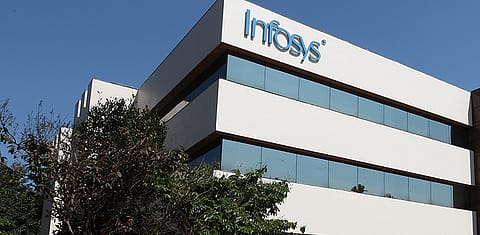Infosys eats Karachi stocks for breakfast!
Pakistan’s mismatch isn’t just military—India’s tech giant alone is worth more than the top 476 Pakistani stocks combined.

While the India–Pakistan conflict has entered a fragile ceasefire zone after Indian armed forces strategically dismantled Pakistan’s defence architecture in just three days, the confrontation was always a match of unequals—militarily and economically. Pakistan’s GDP, at just $350 billion, is a fraction of India’s $4-trillion economy. And that disparity plays out just as starkly in their stock markets.
A quick comparison between the two nations’ equity landscapes tells the story. Based on a currency conversion of 1 Pakistani rupee to 30 Indian paise, the cumulative market capitalisation of the 476 most prominent companies on the Pakistan Stock Exchange (PSX) adds up to ₹5.66 lakh crore. That’s less than the market cap of a single Indian large-cap stock—Infosys—at ₹6.26 lakh crore as of last Friday’s close. In fact, PSX’s total value is only slightly above Hindustan Unilever’s ₹5.48 lakh crore market cap.
Accessing real-time stock data from Pakistan itself wasn’t straightforward. Fortune India relied on data from stockanalysis.com, as the PSX’s official website was either under maintenance or possibly geo-blocked in India during the conflict.
The gap widens when one zooms in further. The combined market cap of the KSE-100, Pakistan’s benchmark index, stands at ₹3.31 lakh crore—less than UltraTech Cement’s ₹3.34 lakh crore market cap.
While the PSX bounced on Friday amid optimism over an impending IMF bailout, continued geopolitical tensions would have likely pressured the market further. Even a modest market decline in Pakistan would put it in the league of mid-sized Indian companies: A 10% drop takes it to ₹2.98 lakh crore—close to Titan Company (₹3.11 lakh crore), a 15% drop aligns it with Adani Ports & SEZ (₹2.82 lakh crore), and a 20% fall puts it near Power Grid Corporation (₹2.78 lakh crore).
Adding to the contrast is the story of MNC stocks in Pakistan, which look like minnows compared to their Indian counterparts. The combined market cap of the six top MNCs in Pakistan—Nestlé, Colgate-Palmolive, Pakistan Tobacco, Unilever Foods, GSK, and Abbott—is a modest ₹36,660 crore. Compare that to the same MNCs listed in India, whose cumulative market cap exceeds ₹14.8 lakh crore, 40 times larger. Their revenue gap is equally stark: ₹17,978 crore in Pakistan vs ₹1.73 lakh crore in India. Even individually, Hindustan Unilever and Nestlé India alone eclipse the entire Pakistani MNC basket.
Even Pakistan’s largest listed entity, the Pakistan government-owned Oil and Gas Development Company (OGDC), has a market cap of just ₹23,812 crore—equivalent to only 1.28% of Reliance Industries’ ₹18.64 lakh crore. To put that in perspective, OGDC’s market value is on par with ₹23,787 crore of JB Chemicals & Pharmaceuticals, and much lower than ₹27,986 crore of Indraprastha Gas, a stated-owned gas distribution player in India’s broader hydrocarbons space. Even if one considers the GDR of OGDC, which trades at $7.80, the market cap of over $3.35 billion (around ₹28,000 crore) is less than NLC India which is over ₹30,000 crore.
Recommended Stories
Also telling is the contrast between the exchanges themselves: compared to the market cap of ₹88,969 crore for BSE India, the Pakistan Stock Exchange’s market cap stands at a mere ₹527 crore—a reflection of its limited investor base, shallow trading volumes, and constrained institutional depth.


